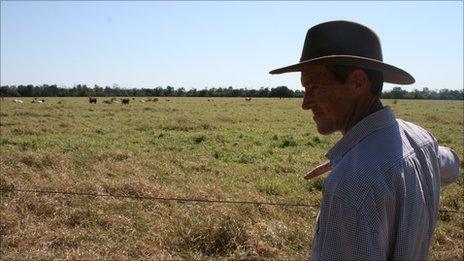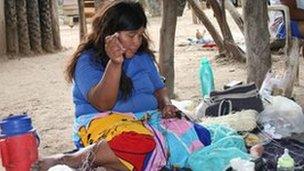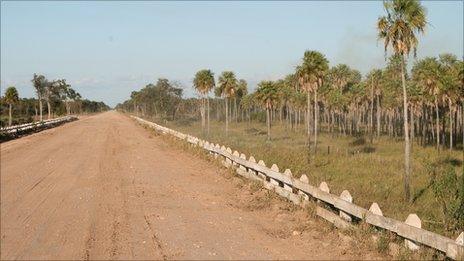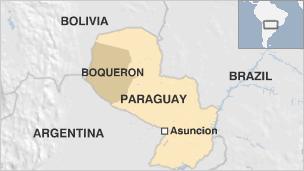Forest fears as Paraguay's Chaco region sees land rush
- Published

Local farmers say land prices have risen a lot in recent years
"My car broke down once here, I had to wait three days to be rescued without food or water," says Tomas Jimenez as we speed along an endless, deserted dirt road.
This is the Chaco in Paraguay, a vast lowland area of forest and thorn scrub so violently hot and inhospitable that even the Spanish Conquistadors in their insatiable hunt for riches struggled to penetrate it.
The region, dubbed South America's Green Hell, stretches across parts of Paraguay and Argentina, as well as Bolivia and Brazil.
British wildlife film-maker David Attenborough has called it "one of the last great wilderness areas left in the world".
This wilderness is also home to uncontacted tribes.
Over the centuries some outsiders have settled here, including Mennonite Christians seeking a new home in the first half of the 20th Century.
But in recent years they have been joined by Brazilian ranchers and private European investors, mainly from France, Germany and the Netherlands.
'Promises and lies'
Their arrival has seen a 21st Century land rush that has wiped out 1m hectares (2.5m acres) - nearly 10% of the forest - in just four years, according to satellite imagery.

Many of the Ayoreo have lost their traditional way of life
The vegetation is burned and bulldozed to create prairie-style grasslands to rear cattle, mainly for export to foreign beef markets.
With land in the Chaco 10 times cheaper than in neighbouring countries, it is an attractive proposition for businesses.
Nowhere is the transformation felt more strongly than in the tiny village of Ijnapui in the heart of Chaco, a small island of forest hemmed in between massive cattle ranches.
It is one of three communities of some 200 Ayoreo indigenous people who have returned to what is left of their ancestral lands.
The Ayoreo had been living in miserable townships on the edge of the three mainly white Mennonite colonies.
"We came out of the forest when I was seven. An Ayoreo sent by a Christian Salesian priest came to the forest one day to bring us out," says Carlos Etacore, the 46-year-old community leader.
"He told us that in the city where whites lived there was lots of water, food and medicines. He promised many things but they were all lies - in three years my mother died of measles."
Warning
But things are scarcely better in Ijnapui, which consists of a few tin-roofed wooden shacks.
People are bloated because of a poor diet and there is so little to eat that they cooked for dinner the few things I brought as a present - some meat and rice, and a bag of pasta.
Men scrape a living by producing charcoal from burning trees which is sold for $1 per kg, while the women knit small bags and bracelets which they try, mostly in vain, to sell.
"Deforestation is very serious nowadays," says Mr Etacore.

The Chaco: Challenging terrain but long fought over
Elias Pena, a prominent Paraguayan scientist, warns that Paraguay could see its forests disappear in 20 years' time.
"In Paraguay our forest law... dates back to the 1970s, permitting up to 75% of a plot of land to be deforested," he says.
"This allows a landowner to deforest, for instance, three-quarters of a 100,000-hectare plot. He then sells the remaining 25,000 hectares to someone else who can then deforest another 75% and so on.
That was how most of the forest in eastern Paraguay disappeared, he says, and this is what is happening in the Chaco.
Market for meat
Local authorities say farming is key to the economic development of the region.
Walter Stockl, the governor of Boqueron province in the Chaco, accuses foreign NGOs of exaggerating the problem.
Their aim, he alleges, is to undermine Paraguayan beef exports by campaigning against the expansion of farmland.
Mr Stockl does not elaborate but he admits later in the conversation that not everything is going well.

"The state presence here only started in the early 1990s. Before that there were only Mennonite communities and Catholic missions. The Chaco has always been a forgotten area," he says.
A senior government official, who did not want to be named, went further, saying that deforestation was out of control.
Regulations, the official said, were inadequate and needed to be urgently changed.
Farmers who have spent their whole lives in this region are also concerned.
Heinrich Dueck, 58, is an Orthodox Mennonite Christian farmer whose family arrived with the initial wave of Mennonites in the 1920s.
Despite having spent his whole life here, the land rush took him by surprise.
He bought 2,100 hectares of land to add to his 500-hectare ranch, fearing that in the future he would be priced out of the market.
"Things are changing fast," Mr Dueck says.
"Four years ago I paid $70 (£45) per hectare for my new plot. Fifteen years ago, I would have paid $20."
Now, Mr Dueck says, the price is $200 - even as high as $500 - a hectare.
Last December the Paraguayan Congress voted down a proposal to stop deforestation in the Chaco.
High-level meetings are currently taking place between the government and competing local interests to try to make meat production more compatible with environmental protection.
But as meat prices continue to rise and with the state presence still very weak, few in the Chaco believe things will change.
- Published7 July 2011
- Published5 July 2011
- Published15 November 2010